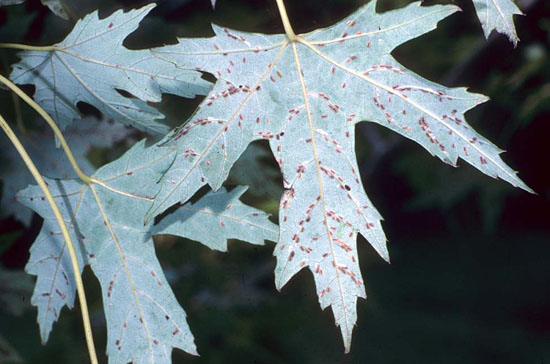Issue 8, June 11, 2010
Cottony Maple Scale
Cottony maple scale, Pulvinaria innumerabilis, is very common this year in northeastern Illinois. This insect occurs in the northern half of Illinois, as far south as Danville and Lincoln. Cottony maple scale occurs most commonly on silver maple, but is also common on other maples including box elder. It is also common on black walnut, honey locust, linden, black locust, red mulberry, and white ash. It is occasionally found on many other tree species. On silver maple, upper branches are mostly defoliated by high infestations and branches are occasionally killed. Cottony maple scale usually does not cause serious injury to other trees.
Cottony maple scale is a lecanium-type scale, being very similar in appearance to European fruit lecanium for most of the year. Mature female scales are brown, roundish, and about one-quarter inch in diameter. They look like tiny army helmets or turtle shells on the branches. At this time of year, they become much more obvious with each mated female producing a white egg mass that is larger than she is. These egg masses with the attached female look like popcorn on the twigs.

The eggs hatch into reddish-brown crawlers in mid-July. They sit for a couple of days on top of the egg mass, appearing like a dusting of paprika. The crawlers are visible on the egg masses of the accompanying photo. The crawlers then move to the leaf undersides along the veins to feed, remaining there until early fall. Males and females mature on the leaves, and tiny winged males emerge to mate with the females. These mated females are about one-eighth inch in diameter and move back to the stems for the winter. In the spring, the mated females grow rapidly and then lay their eggs.

These insects feed on the sap of the tree, tapping into the phloem with their long, needle-like mouthparts. Insects, like other animals, need large amounts of nitrogen, but plant sap contains very little nitrogen. Cottony maple scale, other soft scales, aphids, leafhoppers, treehoppers, and other related insects have the ability to selectively remove the nitrogen, some of the water, and a little of the carbohydrates (sugars) from the sap before it goes through their digestive system. The bulk of the concentrated sap bypasses most of the digestive system to the anus, where it is excreted. In order to obtain the amount of nitrogen that they need, these insects imbibe huge quantities of sap, with most of it being excreted as a thin, syrupy liquid called honeydew.
The honeydew associated with heavily attacked trees will coat the leaves, stems, and branches and also drip to the ground, coating sidewalks, vehicles, lawn furniture, and other objects under the trees. These surfaces appear wet and shiny and are sticky from the honeydew. Occasionally, we get calls from clientele wondering why they can feel it raining under their tree, but not beyond the canopy. This is due to soft scales, aphids, or other sucking insect defecating on them. A black sooty mold grows on the honeydew. Black bark on branches and blackish areas on leaves are signs that sucking insects are attacking the plant or the tree above it. Soft scales and other sucking insects are probably more commonly controlled to eliminate honeydew and sooty mold than direct damage by these insects to the plant.--Phil Nixon
Author:
Phil Nixon